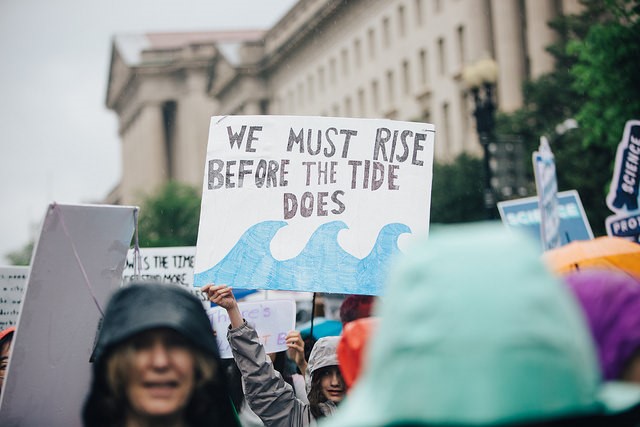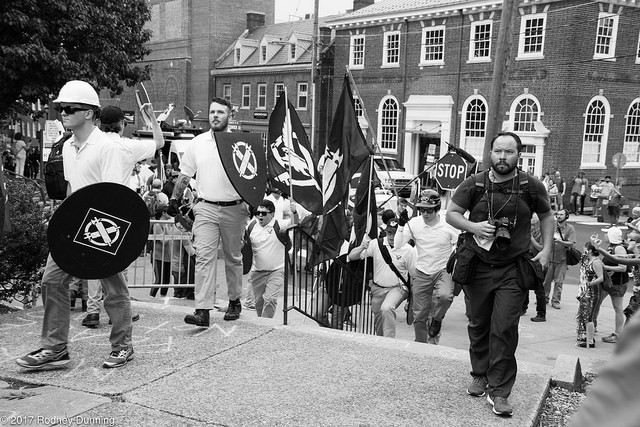The fiscal year ends in a few weeks, and researchers of all stripes are worried about how Trump’s threats to cut funding will pan out. The presidential administration has proposed to slash support for a spectrum of federal agencies including the National Endowment for the Humanities, the National Endowment for the Arts, and the National Institutes of Health. As the March for Science that took place in major cities around the world last April showed, there is a way for academics to work with the public to peacefully and effectively promote intellectual pursuits.

“March for Science” by Molly Adams is licensed under CC BY 2.0
The violence that erupted last month outside the “Unite the Right” rally in Charlottesville, on the other hand, showed the new danger that humanities scholars face as their work and causes are coopted by white nationalists and white supremacists. From the defense of bigotry in terms of “respect for American history” to the misappropriation of medieval imagery to construct an imagined past of racial purity, false pretenses of scholarship pose a serious threat to contemporary arts and letters. As we seek out new ways to promote the humanities in an increasingly volatile public arena, we should consider what lessons can be learned from the gruesome history of town-gown clashes.

“Charlottesville_UniteTheRightRally-0293.jpg” by Rodney Dunning is licensed under CC BY-ND-ND 2.0.
In 1355, a bar brawl between two scholars and a wine merchant in an Oxford tavern led to a free-for-all between members of the university and citizens of the town that spanned several days. It began when the two beneficed clerks, Walter de Springheuse and Roger de Chesterfield, insulted the vintner John de Croydon’s wares and, apparently, launched the wine jug at his head. Townsmen rallied to Croydon’s defense, ringing the bell at the church of St. Martin and opening fire bows and arrows on the clerks. The chancellor attempted to intervene, at which point he was attacked and forced to retreat. He returned with an army of his own and ordered the bell at St. Mary’s to be rung.
The next day, forty townspeople invaded a convent of Austin friars and ambushed a group of clerks at Beaumont Fields. As the students attempted to close the town gates, 2,000 countrymen came to the aid of the townspeople waving a black flag. The slaughter that followed was grisly: halls were sacked and clerks were imprisoned and murdered, their tonsured heads scalped in disdain. One scholar was taken down at the feet of a band of friars who were processing in protest. Severely outnumbered, the clerks were forced to flee and the university shut down.
These days of conflict, known as the St. Scholastica Day Riots, were the culmination of a century of angst between town and gown. Throughout the thirteenth century and well into the fourteenth, as Gordon Leff explains, “royal favor had given the university authorities a stranglehold on the life of the city, juridically, economically, and psychologically.” Oxford was neither the first nor the last place to see this kind of dispute. The struggle between town and gown had generated the “Great Dispersion” of 1229 in Paris, for instance, which had displaced many great minds from France to Oxford and Cambridge in the first place. During the 1381 Peasant’s Revolt, a less bloody but similarly angst-charged riot broke out at Cambridge, where the mayor, bailiffs and burgesses attacked the scholars, pillaged the halls, and confiscated the university’s and colleges’ charters of privileges and other documents, to which they then set fire in the marketplace.
Until recently, what is often called the “crisis in the humanities” felt, to me, like a hyperbole when considered alongside the all-out bloodshed of the St. Scholastica Day Riots, and the deep-seated tensions between scholars and the public that they laid bare. In light of recent events, however, it is becoming ever clearer that researchers are entering the public arena whether we choose to or not, and the stakes of that discourse are escalating.
Erica Machulak, PhD
University of Notre Dame
FURTHER READING
Bennett, J. A. W. Chaucer at Oxford and at Cambridge. Toronto; Buffalo: University of Toronto Press, 1974.
Cobban, Alan B. The Medieval English Universities: Oxford and Cambridge to C. 1500. Berkeley: University of California Press, 1988.
Courtenay, William J. Schools & Scholars in Fourteenth-Century England. Princeton, NJ: Princeton University Press, 1987.
Leff, Gordon. Paris and Oxford Universities in the Thirteenth and Fourteenth Centuries: an Institutional and Intellectual History. New York and Wiley, 1968.
Mallet, Charles Edward. A History of the University of Oxford. London: Methuen & Co, Ltd, 1924.
Rashdall, Hastings. The Universities of Europe in the Middle Ages. Edited by F. M. Powicke and A. B. Emden. 2nd ed. London and New York: Oxford University Press, 1942.
